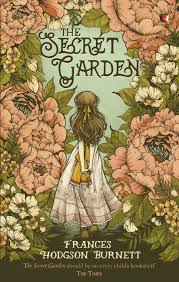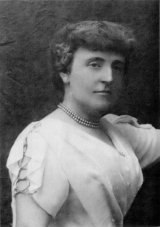The Secret Garden Page #12
The Secret Garden is a novel by Frances Hodgson Burnett first published in book form in 1911, after serialization in The American Magazine. Set in England, it is one of Burnett's most popular novels and seen as a classic of English children's literature. Several stage and film adaptations have been made.
She opened the door of the room and went into the corridor, and then she began her wanderings. It was a long corridor and it branched into other corridors and it led her up short flights of steps which mounted to others again. There were doors and doors, and there were pictures on the walls. Sometimes they were pictures of dark, curious landscapes, but oftenest they were portraits of men and women in queer, grand costumes made of satin and velvet. She found herself in one long gallery whose walls were covered with these portraits. She had never thought there could be so many in any house. She walked slowly down this place and stared at the faces which also seemed to stare at her. She felt as if they were wondering what a little girl from India was doing in their house. Some were pictures of children—little girls in thick satin frocks which reached to their feet and stood out about them, and boys with puffed sleeves and lace collars and long hair, or with big ruffs around their necks. She always stopped to look at the children, and wonder what their names were, and where they had gone, and why they wore such odd clothes. There was a stiff, plain little girl rather like herself. She wore a green brocade dress and held a green parrot on her finger. Her eyes had a sharp, curious look. “Where do you live now?” said Mary aloud to her. “I wish you were here.” Surely no other little girl ever spent such a queer morning. It seemed as if there was no one in all the huge rambling house but her own small self, wandering about upstairs and down, through narrow passages and wide ones, where it seemed to her that no one but herself had ever walked. Since so many rooms had been built, people must have lived in them, but it all seemed so empty that she could not quite believe it true. It was not until she climbed to the second floor that she thought of turning the handle of a door. All the doors were shut, as Mrs. Medlock had said they were, but at last she put her hand on the handle of one of them and turned it. She was almost frightened for a moment when she felt that it turned without difficulty and that when she pushed upon the door itself it slowly and heavily opened. It was a massive door and opened into a big bedroom. There were embroidered hangings on the wall, and inlaid furniture such as she had seen in India stood about the room. A broad window with leaded panes looked out upon the moor; and over the mantel was another portrait of the stiff, plain little girl who seemed to stare at her more curiously than ever. “Perhaps she slept here once,” said Mary. “She stares at me so that she makes me feel queer.” After that she opened more doors and more. She saw so many rooms that she became quite tired and began to think that there must be a hundred, though she had not counted them. In all of them there were old pictures or old tapestries with strange scenes worked on them. There were curious pieces of furniture and curious ornaments in nearly all of them. In one room, which looked like a lady’s sitting-room, the hangings were all embroidered velvet, and in a cabinet were about a hundred little elephants made of ivory. They were of different sizes, and some had their mahouts or palanquins on their backs. Some were much bigger than the others and some were so tiny that they seemed only babies. Mary had seen carved ivory in India and she knew all about elephants. She opened the door of the cabinet and stood on a footstool and played with these for quite a long time. When she got tired she set the elephants in order and shut the door of the cabinet. In all her wanderings through the long corridors and the empty rooms, she had seen nothing alive; but in this room she saw something. Just after she had closed the cabinet door she heard a tiny rustling sound. It made her jump and look around at the sofa by the fireplace, from which it seemed to come. In the corner of the sofa there was a cushion, and in the velvet which covered it there was a hole, and out of the hole peeped a tiny head with a pair of frightened eyes in it. Mary crept softly across the room to look. The bright eyes belonged to a little gray mouse, and the mouse had eaten a hole into the cushion and made a comfortable nest there. Six baby mice were cuddled up asleep near her. If there was no one else alive in the hundred rooms there were seven mice who did not look lonely at all. “If they wouldn’t be so frightened I would take them back with me,” said Mary. She had wandered about long enough to feel too tired to wander any farther, and she turned back. Two or three times she lost her way by turning down the wrong corridor and was obliged to ramble up and down until she found the right one; but at last she reached her own floor again, though she was some distance from her own room and did not know exactly where she was. “I believe I have taken a wrong turning again,” she said, standing still at what seemed the end of a short passage with tapestry on the wall. “I don’t know which way to go. How still everything is!” It was while she was standing here and just after she had said this that the stillness was broken by a sound. It was another cry, but not quite like the one she had heard last night; it was only a short one, a fretful childish whine muffled by passing through walls. “It’s nearer than it was,” said Mary, her heart beating rather faster. “And it is crying.” She put her hand accidentally upon the tapestry near her, and then sprang back, feeling quite startled. The tapestry was the covering of a door which fell open and showed her that there was another part of the corridor behind it, and Mrs. Medlock was coming up it with her bunch of keys in her hand and a very cross look on her face. “What are you doing here?” she said, and she took Mary by the arm and pulled her away. “What did I tell you?” “I turned round the wrong corner,” explained Mary. “I didn’t know which way to go and I heard someone crying.” She quite hated Mrs. Medlock at the moment, but she hated her more the next. “You didn’t hear anything of the sort,” said the housekeeper. “You come along back to your own nursery or I’ll box your ears.” And she took her by the arm and half pushed, half pulled her up one passage and down another until she pushed her in at the door of her own room.
Translation
Translate and read this book in other languages:
Select another language:
- - Select -
- 简体中文 (Chinese - Simplified)
- 繁體中文 (Chinese - Traditional)
- Español (Spanish)
- Esperanto (Esperanto)
- 日本語 (Japanese)
- Português (Portuguese)
- Deutsch (German)
- العربية (Arabic)
- Français (French)
- Русский (Russian)
- ಕನ್ನಡ (Kannada)
- 한국어 (Korean)
- עברית (Hebrew)
- Gaeilge (Irish)
- Українська (Ukrainian)
- اردو (Urdu)
- Magyar (Hungarian)
- मानक हिन्दी (Hindi)
- Indonesia (Indonesian)
- Italiano (Italian)
- தமிழ் (Tamil)
- Türkçe (Turkish)
- తెలుగు (Telugu)
- ภาษาไทย (Thai)
- Tiếng Việt (Vietnamese)
- Čeština (Czech)
- Polski (Polish)
- Bahasa Indonesia (Indonesian)
- Românește (Romanian)
- Nederlands (Dutch)
- Ελληνικά (Greek)
- Latinum (Latin)
- Svenska (Swedish)
- Dansk (Danish)
- Suomi (Finnish)
- فارسی (Persian)
- ייִדיש (Yiddish)
- հայերեն (Armenian)
- Norsk (Norwegian)
- English (English)
Citation
Use the citation below to add this book to your bibliography:
Style:MLAChicagoAPA
"The Secret Garden Books." Literature.com. STANDS4 LLC, 2024. Web. 25 Nov. 2024. <https://www.literature.com/book/the_secret_garden_427>.




Discuss this The Secret Garden book with the community:
Report Comment
We're doing our best to make sure our content is useful, accurate and safe.
If by any chance you spot an inappropriate comment while navigating through our website please use this form to let us know, and we'll take care of it shortly.
Attachment
You need to be logged in to favorite.
Log In